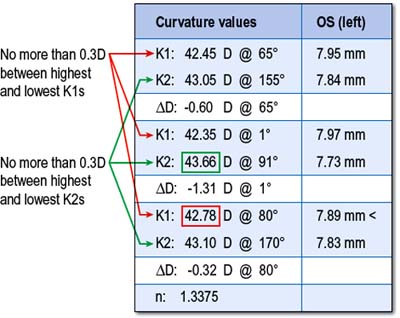CHAPTER 9 Preoperative assessment including biometry
Biometry is a vital part of the cataract process because the effective IOL power largely controls the final refractive error. That refractive error is the ‘take home’ element of the surgery, and will remain virtually unchanged for the rest of the patient’s life. An incorrect IOL is a leading cause of successful litigation in ophthalmology1.
Sources of error in keratometry
Keratometry errors that are difficult to control for include:
Errors that can be avoided include:
One key measure is repeatability. The surgeon should insist that at least three readings are recorded, and with each meridian being considered separately they should be within 0.30 D of each other. In Table 9.1, the third K1 reading is more than 0.3 D different from the other two. Similarly, one of the K2 readings is different. They cannot all be right, so repeat readings should be taken, using a drop of saline on the cornea to improve wetting.




